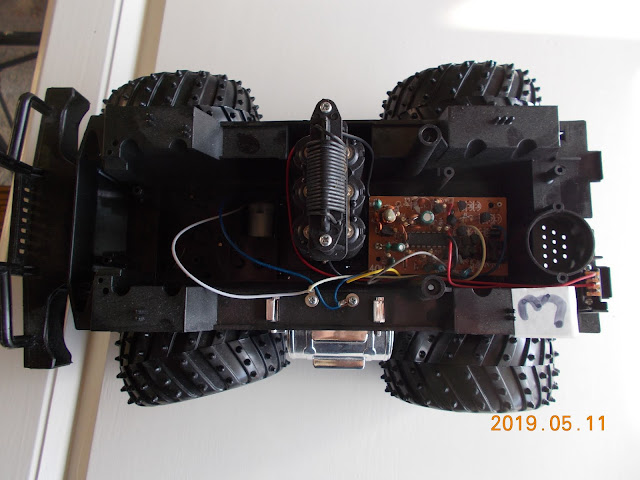I seem to have been collecting cars to experiment on. This is what I have now.
Car #1 The one in the video, It was using a program called WebIOpi that became obsolete after an update to Raspbian. Also the original driver board broke after it was touched wrongly and has now been replaced by a Deek-Robot board. It still works.
Here is the video: https://www.youtube.com/watch?v=l8Xdn60oFQY&feature=youtu.be
and the deek-robot driver board.
I only paid about a pound for this, but it works fine.
Car # 2
This has taken a bit of work to get going because I have been trying to make a harness that can be moved between cars. What drove this is that Cars 1,2 &3 all have a 16 pin dual in-line receiver chip on them that have the same pinouts for forward and back, left and right. On car 2 I replaced the IC with a DIL socket. The software that this is using is built on Flask from an article in Linux Format.
Car #3 I have not touched this one yet, but as can be seen, it has the 16 pin DIL chip there for when I do get around to it.
This one was a 40MHz radio. It's the one that gave me the idea to make a common interface connection from the Raspberry Pi.
Car #4 This one has a 16 pin IC surface mount and a bit smaller, but I'll bet that the pinouts are the same. I'll have to modify the connections from my 16 pin DIL Header to connect to it. This one says it is 2.4GHz and it is a Maisto brand. Because of my history with Wifi with Telxon and the university, I wanted to try and drive it directly but a previous blog describes why this idea was a non-starter.
That's it to date. Next step is to post a video of car #2 in operation.
25 June 2019:
In Car 2 the IC that has been replaced by a socket so that the harness from the R-Pi can plug straight in has the following pinouts. This enabled me to build the harness. Note that the poor creation of this jpg has the 'right' label too high and it should be on pin 6.
Now the pinouts for the IC from Car 3 are as follows:
Which is the same. For anybody who wants to check this, car 3 is a 40MHz unit using SM6135W IC and car 2 was a 27MHz and I'll have to look back in these blogs to find the IC part number.
The reason for belabouring this point is that with the R-Pi3w and the software in card #7, car 2 behaves well, but car 3 is all topsy turvy in that the L/R buttons make it go Forward/Backward, and the F/B buttons turn the car. I don't understand it.







No comments:
Post a Comment